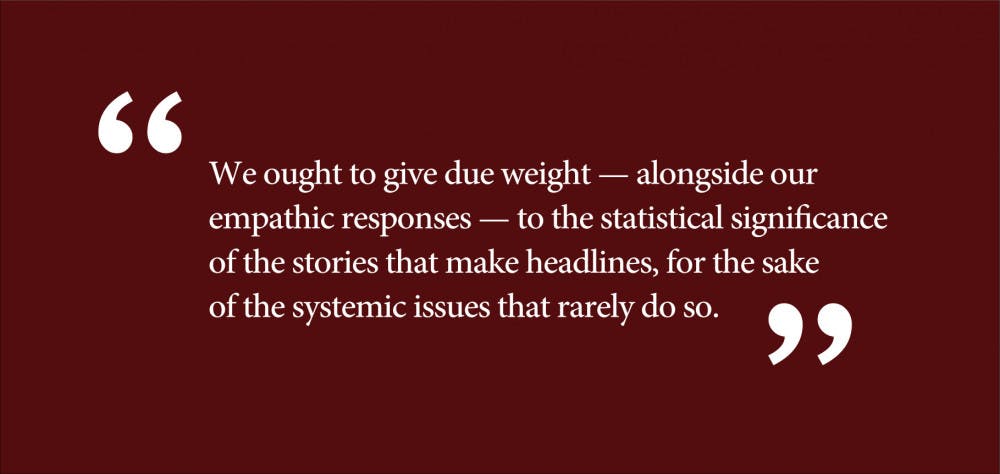“The death of one man is a tragedy; the death of millions is a statistic,” Joseph Stalin was reputed to have said. This (likely misattributed) quotation still bears a certain eeriness by its connection to the 20th century dictator, whose regime bore responsibility for millions of deaths by ethnic cleansings, executions and famines — and ultimately, the statement is eerie because it is true. We evaluate issues on the basis of their emotional salience, which more often than not biases our perception of them. This is a well-documented phenomenon in psychology: the availability heuristic is the mental shortcut whereby people overestimate the importance of examples that are vivid and readily available to them. Everyone knows the kinds of stories that are guaranteed to make headlines: The deadly terrorist attack and the most recent mass shooting. These stories engender more empathy and more anger than other, more pervasive issues. The media endlessly relates their vivid narratives, their horrific details and their clear-cut bad guys. But this leaves public outrage with a blind spot for the victims of the more commonplace and widespread tragedies. To evaluate issues clearly, we must look beyond the stories and instead at the numbers. We ought to give due weight — alongside our empathic responses — to the statistical significance of the stories that make headlines, for the sake of the systemic issues that rarely do so.
Compare the perceived threat of terrorism with deadlier risks looming incessantly over all of us. Defense against terrorism, according to Pew Research, has remained for most Americans a “top policy priority” every year since 2001 — 73 percent of U.S. adults thought so in 2018, with more agreement on this than on any other policy priority. But the threat of terrorism is comparatively insignificant for Americans. On Sept. 11, 2001, the terrorist attacks killed approximately 3,000 people. During the next 15 years — from then until Dec 31, 2016, according to the U.S. Government Accountability Office — 85 attacks in the U.S. met the criteria for acts of domestic terrorism, and these killed a total of 225 people. In 2016, by contrast, heart disease, the leading cause of death, killed 635,260 people. In that year alone, car crashes killed 37,461 people, with an average of 102 deaths per day. To be clear, these are not fair comparisons to make. The issues could not be more disparate and could not require more disparate types of policy interventions — apples to oranges. But terrorists capture the American imagination because they make for catchy headlines and for compelling outgroups. It is beyond the scope of this article to urge a reassessment of the billions spent on fighting and protecting against terrorism. But if one wants to understand the biggest threats to the welfare of the majority of Americans, one ought to resist the flashiness of current headlines and stories in the media and instead ought to put the issues in perspective.
Also consider the comparison of America’s problem of mass shootings in particular with that of guns in general. Paul Bloom, Yale psychologist and author of the controversial book “Against Empathy: The Case for Rational Compassion,” made the point in 2013 that mass shootings in the previous 30 years had accounted for only about one-tenth of one percent of homicides in the United States. More recently, the Gun Violence Archive, a joint initiative of the New York Times and Reddit, estimated that 358 mass shootings took place in 2015. While this number is shocking, it is also important to keep in mind that homicides in 2016 accounted for 11,004 deaths. For a decade, guns in these homicides have annually killed between 10,000 and 15,000 people. Moreover, in 2016 alone, guns used in suicides killed 22,938 people, after a gradual rise annually over the last decade. Of course, the United States has a huge epidemic of mass shootings, especially in comparison with any other developed nation. It is also important to acknowledge that mass shootings disproportionately affect black Americans, as the Guardian reported — a reality that is obscured by looking at death tolls in just numbers. But the media’s disproportionate emphasis on mass shootings when you consider the number of fatalities that result from suicides and homicides skews our understanding of America’s gun problem. It is in the media’s nature to cover the sensational, and I am taking no stance here on the policy interventions that should be drawn from these statistics. I am saying only that to understand the nature and the extent of the problem of guns, we have to look at the numbers.
It might be argued that emotionally salient events such as terrorist attacks and mass shootings carry with them a psychological burden that cannot be quantified — that people want to feel safe as much as they want actually to be safe, and that those two are not the same. As a result, these threats can loom large and preoccupy our minds. It goes without mention how naive it is to wish that statistics could move people in the way that an emotive story does. But the widespread and growing popularity of movements such as effective altruism — which encourages rational giving so as to help the greatest possible number of people — does give me hope that rational evaluation can indeed influence people on a large scale. By all means, we should follow our hearts or listen to that feeling in our gut; but, as we do, we have to keep the numbers in mind for the sake of perspective.
James Flynn ’20 can be reached at james_flynn1@brown.edu. Please send responses to this opinion to letters@browndailyherald.com and op-eds to opinions@browndailyherald.com.





